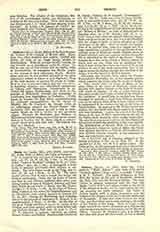

Cedron, BOOK OF (Heb. NCHL QRRVN Ndhdl Qidhron, “Wadi Qidron”; only once SRTVT QRRVN “fields of Qidron”; John, xviii, 1, ho cheimarrhos ho Kedron; in R. V., Kidron). The name designates in Holy Writ the ravine on the east of Jerusalem, between the Holy City and the Mount of Olives. The word Cedron is usually connected with the root rip, Qadar, “to be dark”, and taken to refer to the color of the stream or ravine; but its exact origin and precise meaning are really unknown. The Valley of Cedron begins with a slight depression near the Tombs of the Judges, a mile and a quarter northwest of Jerusalem. It runs first south towards the Holy City, and then turns nearly east, passing to the north of the Tombs of the Kings. Next, it bends to the right towards the south, deepening as it follows this general direction between Jerusalem and the Mount of Olives. Opposite St. Stephen’s gate, it is fully 100 feet deep and about 400 feet broad; its bed is shaded by venerable olive-trees and crossed by an old bridge. Below the bridge, the valley presents the first traces of a torrent bed. It narrows gradually and. sinks more rapidly, leaving to the east the church of the Tomb of the Blessed Virgin, and next, Gethsemani. A thousand feet from the old bridge, the valley is merely a deep gulley across which another bridge is thrown, and on the banks of which are, to the right, Mohammedan tombs, and to the left, the sepulchres of Josaphat, Absalom, St. James, and the Jewish cemetery. About a thousand feet farther, there is in a cave, on the right bank, the Fountain of the Virgin, and higher up, on the left, the village of Siloe. Somewhat farther down, the Tyropceon valley falls from the right into the Cedron, which now expands down to the Valley of Hinnom. Here, the Cedron is about 200 yards wide, and has on its left the Mount of Of-fence. Shortly after the junction of the Valley of Hinnom with the Cedron, there is Job‘s well, to the south, of which Sir C. Warren found, in 1868-1869, the shaft of a great rock-cut aqueduct.
On leaving the Holy City, the Valley of the Cedron runs its winding and gradually precipitous course through the Wilderness of Judea to the northwestern shore of the Dead Sea. The Cedron is perfectly dry during the summer and most of the winter. North of Jerusalem, it bears the name of Wadi al-Jos (Valley of Nuts); between the city and the Mount of Olives, it is known as Wadi Sitti Mariam (Valley of St. Mary), or again as the Valley of Josaphat (cf. Joel, iii, 2, 12); after leaving Jerusalem, it is called Wadi en-Ndr (Valley of Fire), and also Wadi er-Rahib (Valley of the Monks). Its whole length is some 20 miles in a straight line, and its descent nearly 4000 feet. Its bed east of Jerusalem is now about 40 feet higher than in ancient times. The Cedron is first mentioned in Holy Scripture in connection with David’s flight from Absalom, during which he crossed it [II K. (A. V. II Samuel) xv, 23]; and next, in connection with the prohibition to Semei against his ever crossing it [III K. (A. V. I K.) ii, 37]. It was at the torrent Cedron that King Asa burnt the filthy idol of his mother [III K., xv, 13; II Par. (A. V. II Chron.) xv, 16]. It was into it that Ezechias and Josias cast all the impurities which had polluted the House of the Lord (cf. II Par., xxix, 16; xxx, 14; IV K., xxiii, 4, 6, 12). The torrent Cedron is last mentioned in the O. T. in Jer., xxxi, 40, apparently as part of the common cemetery of Jerusalem. In the N. T. it is spoken of only once, in connection with Christ’s going forth over it to Gethsemani (John, xviii, 1). In the present day it is the desired resting-place of both Jews and Mussulmans, and the supposed scene of the Last Judgment.
FRANCIS E. GIGOT

